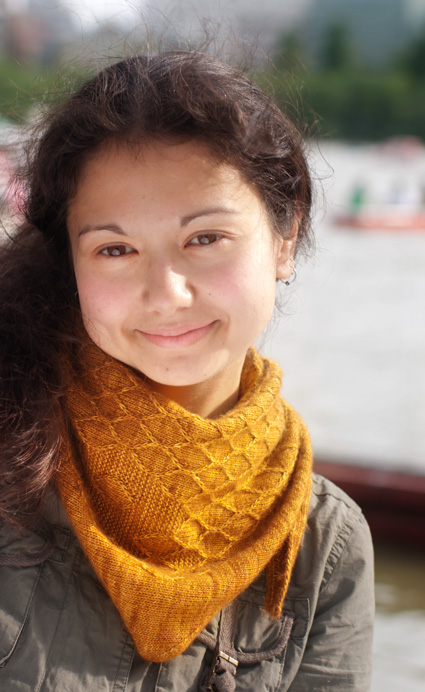

|
|
|

Description of pattern: Apis Dorsata Laboriosa (a.k.a. the Himalayan honey bee) dwells in the mountains of Bhutan, Nepal, China, and India. These giant bees build large yellow and golden honeycombs that hang down from the cliffs. This scarf is inspired by the workmanship of the bees. This pattern includes two sizes, a scarf and a shawl, both made
from Madelinetosh Tosh Merino 100% superwash merino
wool. The scarf is made from Tosh Merino Light and is knit on
US size 1 needles. The fingering-weight yarn and small needle
create a light fine gauge fabric with a more delicate honeycomb.
The honeycomb pattern is created by using a combination of slipped
stitches, stockinette stitch, and garter stitch.
The variation in this hand-dyed yarn adds depth to the pattern
by creating rich natural highlights. The triangular shaped scarf
begins with a tubular cast on and is worked from end to end,
increasing every other row and finishes with a tubular cast off. |
||
|
|

|
Tweet
|
|
SIZE |
|
|
FINISHED MEASUREMENTS |
|
MATERIALS Shawl Notions |
|
GAUGE |
Scarf: 40 sts / 50 rows =
4" in chart pattern, after blocking |
|
PATTERN NOTES |
|
When using hand-dyed yarn, alternate between skeins every two rows for best color results. To keep the edges of the piece looking neat, I chose to alternate skeins after the first stitch marker on RS rows. This project uses a tubular cast on and
bind off. Use your preferred
tubular cast on and bind off techniques, or directions may be
found here: LLI (Left Lifted Increase): Use the left needle to pick up the stitch 2 rows below the last stitch on the right needle. Knit into this stitch. 1 stitch has been increased. LSST (Left Slipped-Slitch Twist): Slip next 2 sts knitwise to right needle. Insert tip of left needle into the fronts of these 2 sts from right to left, and slip them back to left needle in this position; order of sts has been reversed. K first st, sl second st purlwise. RSST (Right Slipped-Slitch Twist): Slip next 2 sts together,
knitwise, as if to work a k2tog. Slip the st closest to the tip
of the right needle back to the left needle, then k this st. |
Scarf Charts in pink updated October 6, 2011 |
|
DIRECTIONS From this point on, work first and last 4 sts of each row in
1x1 Rib as set, slipping first st of each row. CHARTED SECTION IMPORTANT: Because the charts for this pattern are very large, only
RS rows are shown. Row numbers given include 1 WS
row worked after each RS row. Maintaining 4 sts at each edge in pattern as set, work sts between markers following charts as follows. For Scarf:Work Rows 1-132 of Scarf Chart A. 97 sts. Work Rows 1-164 of Scarf Chart B, working outlined pattern repeat section seven times in each row. 138 sts at end of Row 82; 97 sts at end of Row 164. Work Rows 1-142 of Scarf Chart C. 26 sts. Proceed to Last Corner. For Shawl: LAST CORNER Work 2 rows in pattern. |
|
FINISHING |
| ABOUT THE DESIGNER |
|
Anna lives just outside of Tokyo with her
photo-geek husband. She spends most of
her time knitting whatever takes her fancy
and if she has any time to spare she enjoys
sewing, reading, snapping photos and exploring.
|
|
Pattern & images © 2011 Anna Sudo. Contact Anna |